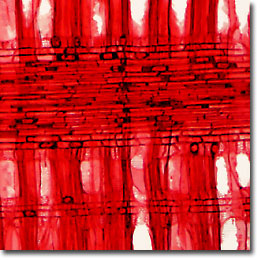The Sweetgum
The Sweetgum (Liquidambar styracifula; also known as the Redgum) is a hardwood tree found primarily in extreme southwest Connecticut south to central Florida, and west to eastern Texas and southern Illinois. A member of the Witch-hazel family (Hamamelidaceae), the tree grows to heights of 125 feet and was first introduced into the continent from Europe about 1680. Sapwood is termed sap-gum in the trade, and is white with a frequent pink tinge, although it is often discolored with blue sap stain. The heartwood is referred to as red-gum and is gray to varying shades of reddish brown.

Cross Section

Radial Section

Tangential Section
Propagation of this deciduous tree is by seed or layering, and the tree is not particular about the type of soil, but requires plenty of sun and room to grow. Sweetgum is the only commonly cultivated species of the Liquidambar genus, which is named after the fragrant resin of an Asiatic species. In the fall, sweetgums display a dazzling array of yellow, red, and purple colors on their lobed, maple-like leaves. Sweetgums grow up to 75 feet in height and have alternating leaves with three to seven toothed lobes. The flowers are small and inconspicuous, but lacking petals.
The sweetgum can be considered a living fossil. Today there are three existing species of Liquidambar: one is found in Formosa, one in Turkey, and one is native to America. Twenty extinct species are known, the oldest found in the Upper Eocene rocks of Greenland, in an age when that continent had a subtropical climate, some 55 million years ago. Sweetgum veneer is used extensively in furniture, panels, and for various cheap containers such as fruit baskets, boxes, crates, and cigar boxes. Sweetgum lumber is also used for mill products (especially trim), furniture, radio, television, and kitchen cabinets, boxes, crates, and pallets.
Microscopic examination of iron-alum hematoxylin and safranin stained thin sections (see the digital images presented above) reveals a diffuse porous wood having scalariform perforation plates with numerous bars. The vessels are quite plentiful and small to medium in size. Inter-vessel pits are 6 to 30 micrometers in size and occur in transverse rows. Parenchyma is sparse and fiber tracheids are moderately thick-walled and medium to very coarse in texture. The rays are unstoried and of two types: narrow uniseriate and homocellular; and wider 2 to 3 seriate. When present, gum canals are arranged in a uniseriate tangential row, each with an angled orifice.